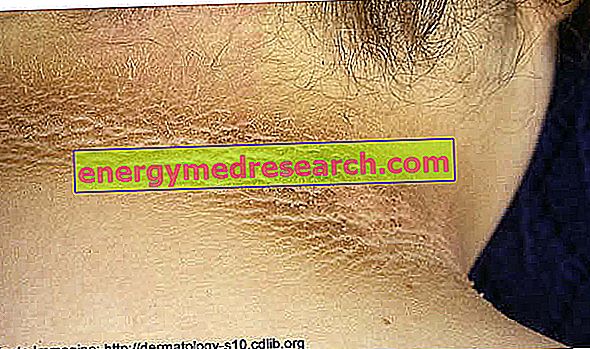Generality
Acanthosis nigricans is a dermatosis (skin disease) characterized by hyperkeratosis (increase in thickness) and hyperpigmentation (darkening) of the skin, with the appearance of dark skin areas especially near the folds of the body. In most cases, the most affected sites are armpits, groin and neck.
Acanthosis nigricans is not contagious or harmful, but sometimes represents a warning sign for a health problem that requires medical attention. This dermatosis, in fact, is commonly associated with obesity, hyperinsulinemia and polycystic ovary syndrome. More rarely, this alteration of the skin can be a warning sign for particular malignancies that affect an internal organ, such as the stomach. There is no specific treatment for acanthosis nigricans, but the therapeutic management of the basic medical condition can usually restore the normal pigmentation of the affected areas.

See also: Photo Acanthosis nigricans Benigna and Photo Acanthosis nigricans Maligna
Causes
Acanthosis nigricans can be benign or associated with an underlying malignancy.
People can develop this condition for many reasons. Obesity and all situations characterized by an excess of insulin in the blood are the main causes of acanthosis nigricans. In particular, when the appearance of skin lesions is linked to obesity, weight management is an important component of treatment: a diet that helps reduce insulin can also help prevent acanthosis nigricans.
Benign form
The benign form affects mainly people under the age of 40, can be genetically inherited and is mostly associated with endocrinopathies such as hypothyroidism, acromegaly, polycystic ovarian disease, insulin-resistant diabetes or Cushing's disease. It is not, however, associated with hyperthyroidism.
Endocrine and metabolic diseases
The most common cause of acanthosis nigricans is insulin resistance, which induces an increase in circulating levels of this hormone secreted by the pancreas. The high concentration of insulin in the blood can trigger abnormal growth of skin cells (hyperplasia). High circulating levels of the hormone probably activate insulin-like type 1 growth factor receptors (IGF1-R), which drive the rapid proliferation of keratinocytes and melanocytes. The condition most commonly associated with insulin resistance is type 2 diabetes mellitus, but it is also a common feature in cases of obesity and polycystic ovary syndrome (PCOS). Controlling blood glucose levels through exercise and diet often improves symptoms.
Other diseases and syndromes associated with acanthosis nigricans are:
- Donohue syndrome (very rare congenital disease that presents an extreme insulin resistance);
- Rabson-Mendenhall syndrome (rare genetic disorder characterized by insulin abnormalities);
- Thyroid disorders (such as hypothyroidism);
- Disorders of the pituitary gland (Cushing's syndrome, acromegaly etc.);
- Adrenal gland disorders (such as Addison's disease).
drugs
Acanthosis nigricans can be induced? Also by particular drugs, such as birth control pills, diethylbestrol or thyroid drugs, and even by some supplements. All of these drugs can cause an alteration in insulin levels, raising their concentration. Growth hormone therapy, systemic corticosteroids, high doses of niacin and some medicines used to alleviate the side effects of chemotherapy can also contribute to the onset of acanthosis nigricans. In most cases, the condition resolves when drugs are suspended.
Malignant forms
Acanthosis nigricans may occur less commonly as a result of specific paraneoplastic syndromes with mucus-cutaneous involvement (gastric carcinoma, lung cancer, carcinoma of the uterus and pancreatic cancer). In the context of an underlying aggressive tumor, dermatosis is therefore referred to as acanthosis nigricans maligna . Generally, this form is characterized by a sudden onset and affects subjects older than 40 years. Among the most frequently associated neoplasms we recall:
- adenocarcinoma of the gastrointestinal tract (especially stomach and colon) or uterus;
- less commonly: lung, prostate, breast or ovarian cancer.
Lesions of the acanthosis nigricans maligna are recognizable, as they involve structures - such as the mucous membranes of the oral cavity or the tongue, the mucosa of the nose, esophagus and larynx - generally not affected by the most common benign forms.
Other causes
Acanthosis nigricans can also occur in the presence of some genetic diseases (example: dysplasia of Saddan), while on other occasions the appearance of dark spots does not appear to have any connection with other medical conditions (idiopathic cause).
Risk factors
Acanthosis nigricans can affect individuals of any age (including children) and of all ethnic groups. However, it is more common in adults and in people with darker skin, such as Native Americans, Hispanics and some African populations. Males and females are affected equally.
The individuals most susceptible to developing acanthosis nigricans are:
- Overweight or obese people;
- Subjects with endocrine or metabolic alterations;
- Patients who take certain medications on a regular basis (eg oral contraceptives, systemic corticosteroids, etc.);
- Subjects subjected to kidney transplantation;
- People with a malignant tumor on an internal organ (a very rare cause of acanthosis nigricans, specifically malignant).
Signs and symptoms
Changes in the skin are the only signs of acanthosis nigricans. Skin changes tend to develop slowly, sometimes over months or years. If they appear suddenly, you should immediately consult a dermatologist, as the lesions could represent a warning sign for very serious pathological conditions.
At the skin level we can note:
- Dark spots, which can vary in color from gray to brown or black, located near the folds of the body;
- The lesions appear as "velvety" thickenings (dry and rough skin) compared to the surrounding skin;
- Dark brown skin can rise to form small ridges (papillomatosis);
- The affected area can also be smelly or itchy.
The body folds most commonly affected by the onset of acanthosis nigricans include:
- Sides and back of the neck;
- Armpits;
- Groin.
Less frequently, skin lesions of acanthosis nigricans can also affect these areas:
- Face (front);
- Inner thighs;
- Elbows;
- Knees;
- Otherwise;
- Navel or belly.
Very rarely, acanthosis nigricans can develop into:
- Nipples;
- Palm of the hand;
- Foot plant;
- Eyelids;
- Lips;
- Oral cavity;
- Anus.
Complications
Sometimes, even a small skin alteration can represent an early warning sign for an underlying pathological condition, which requires treatment. For this reason, it is important to consult a dermatologist if you notice a dark or thicker skin area, especially if the change appears suddenly. People with acanthosis nigricans are more likely to develop type 2 diabetes: skin lesions can be a sign of prediabetes and therefore making some lifestyle changes can prevent the onset of the disease itself. If the acanthosis nigricans tends to spread and involve other less commonly affected areas, such as hands or lips, it should require immediate medical attention. In these cases, moreover, the patient must be checked for the types of malignant tumors that have been linked to the disease.
Diagnosis
The doctor will certainly try to establish what is causing skin hyperpigmentation and thickening. Acanthosis nigricans, in general, is easily recognized during a skin examination, so only in rare cases the specialist decides to take a small sample of skin ( biopsy ) for histological characterization. To define the acanthosis nigricans, your doctor may recommend blood tests, x-rays or further analysis to rule out other possible causes.
Treatment
In many situations, treating the underlying condition can restore normal skin pigmentation. The management of the benign form associated with obesity and insulin resistance states is based on the reduction of insulin levels in the circulation; often a simple diet helps to significantly resolve skin lesions. Other underlying clinical conditions must be treated appropriately (as in the case, for example, of thyroid pathologies or disorders of the adrenal glands). If the condition is drug induced, the doctor may consider the option of modifying or replacing the prescription of the offending medicines.
Once the basic medical condition has been confirmed from the diagnostic point of view, to improve the appearance of the skin, or if the lesions become itchy or smelly, the doctor can indicate a topical cream or a lotion.
The treatment of acanthosis nigricans includes the following:
- Weight loss by changing eating habits and practicing regular exercise;
- Preparations containing alpha-hydroxy acids, such as glycolic acid or lactic acid;
- Lotions containing salicylic acid ;
- Creams containing urea (often recommended in concentrations of 20%);
- Cortisone cream (if the areas are itchy);
- Retinoids, such as tretinoin (Retin-A), tazarotene or adapalene, to whiten the affected areas (they mainly perform an exfoliating action, renewing the more superficial layers of the dermis);
- Antibacterial soaps or a topical antibiotic to reduce odor and discomfort .
None of these treatments is specifically designed for the treatment of acanthosis nigricans, but all can help alleviate the signs caused by the disorder.
Treatment of the most resistant cases of Acanthosis nigricans may include:
- Fish oil, to be included in the diet by taking food supplements;
- Isotretinoin, a potent drug usually used in the treatment of scars and acne.
Some procedures for the aesthetic treatment of acanthosis nigricans include:
- Dermabrasion, a mechanical controlled surgical scraping process of the skin, which can be helpful in reducing the consistency of some affected areas;
- Laser therapy, to reduce the thickness of the skin (destroys the most superficial layers).
Tips
Tips for managing acanthosis nigricans
Maintaining a healthy lifestyle can prevent the onset of acanthosis nigricans in susceptible individuals, as well as reducing the risks for many other types of diseases. Losing weight, controlling the diet and replacing the drugs that are contributing to the condition are all crucial steps. Dermatologists can then advise their patients with acanthosis nigricans:
- Adopt a controlled and healthy diet. Obesity is the most common cause of acanthosis nigricans in adults and children. Studies show that when obese subjects lose a significant amount of body weight, a spontaneous improvement of the lesions can be recorded.
- Before using a lightening cream, an exfoliant or another skin care product, ask a dermatologist for advice. Some products, in addition to not producing positive effects on hyperpigmented and thickened spots of the acanthosis nigricans, can help to irritate the skin, worsening the condition.



